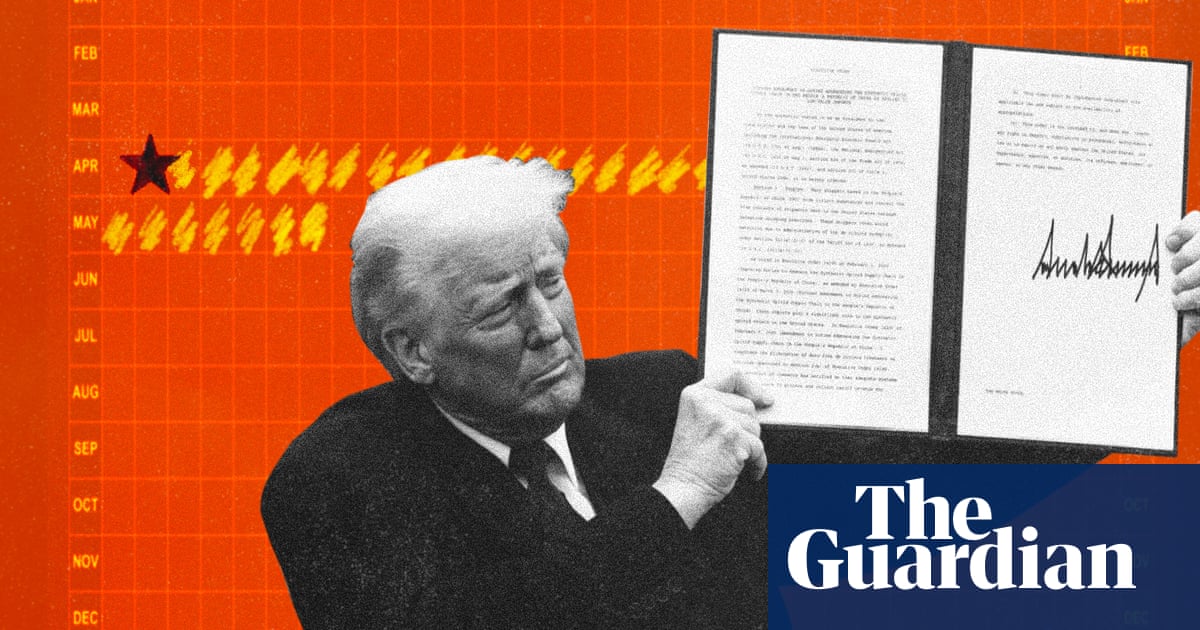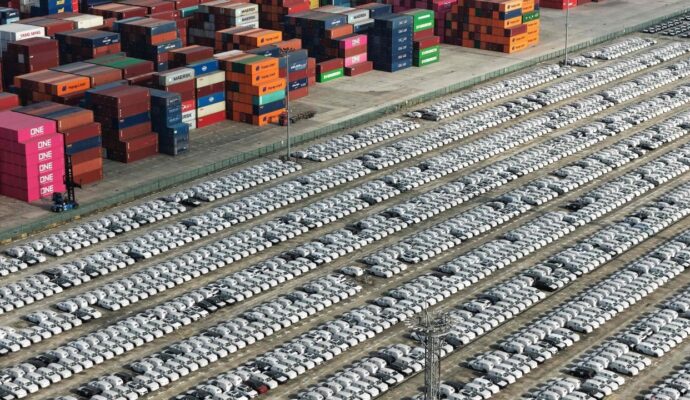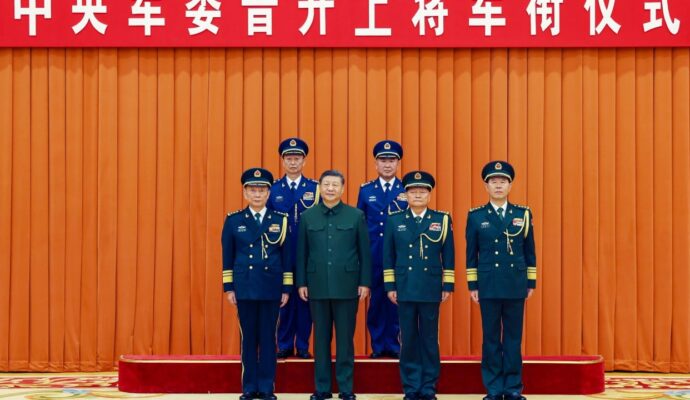
Donald Trump hailed a new chapter in the US’s economic history on 2 April, dubbed “liberation day” by his administration, as he announced plans for an extraordinary barrage of US tariffs on the world. The chapter lasted 40 days.
The page has already been turned. But the impact of those six chaotic weeks, from higher prices to slowing growth, is still unfolding – and the US president is already threatening further adjustments. The story continues.
Trump had been steered away from his aggressive instincts on trade during his first term, and persuaded to walk back several tariff threats in the opening months of his second. But back in early April, he was determined to plough ahead.
“April 2nd, 2025, will forever be remembered as the day American industry was reborn, the day America’s destiny was reclaimed, and the day that we began to make America wealthy again,” Trump declared at an event in the White House Rose Garden, before an audience of his top officials and supporters.
The measures were blunt and severe: a blanket 10% tariff on all imported goods, and higher individualized rates, of up to 50%, on dozens of markets – those of economic allies and rivals alike – deemed to have treated the US poorly on trade.
‘Be cool’
First came the questions. How exactly did the Trump administration come up with such an array of specific duties to impose upon goods from so many countries and territories? And why was a group of barren, uninhabited islands near Antarctica among them?
Then came the panic. Global stock markets tanked, with Wall Street enduring its steepest falls since the onset of the Covid-19 pandemic five years ago, as the president repeatedly insisted he was serious this time.
Trump’s officials were sent out to hold the line. “The announcement today is the most significant action on global trade policy that has taken place in our lifetimes,” said Stephen Miller, his deputy chief of staff for policy. “We’re just going to have to wait and see” what happens, the treasury secretary, Scott Bessent, told Bloomberg. One thing’s for sure, the commerce secretary, Howard Lutnick, told CNN: “The president is not going to back off.”
On day five of the new chapter, the 10% baseline tariffs came into force. On day seven, the higher, individualized rates followed. Beijing vowed to retaliate. Business leaders, including some who had backed Trump’s run for the White House, urged him to reconsider.
A sell-off in treasury bonds, typically deemed a safe haven during periods of economic volatility, took hold. “BE COOL! Everything is going to work out well,” Trump wrote on Truth Social, adding a few minutes later: “THIS IS A GREAT TIME TO BUY!!! DJT”
This advice seemed prescient four hours later. Seven days into the new chapter, with his individualized tariffs imposed for all of 13 hours, Trump announced a 90-day pause – in effect reducing the universal duty on all US imports from almost all countries to 10% – and markets surged higher.
Almost all countries, that is, except China. Beijing’s pledge to hit back infuriated the president, who blamed its “lack of respect” as he announced a new US tariff of 125% (in effect, once other duties were included, 145%) on Chinese goods. It retaliated in kind.
Getting yippy
The same officials who had been dispatched to defend Trump’s initial plan were sent out again, to explain his latest climbdown.
“You have been watching the greatest economic master strategy from an American President in history,” Miller claimed on X.
“Many of you in the media clearly missed The Art of the Deal,” the press secretary, Karoline Leavitt, scolded reporters, referring to the president’s 1987 bestseller, in which the real estate tycoon presented himself as a consummate dealmaker.
While his aides claimed that more than 75 countries had been in touch following his initial tariff announcement, even the president struggled to present the reversal as part of a carefully orchestrated negotiating strategy. Asked what had prompted it, Trump told reporters people had been “getting a little bit yippy” about his plan.
But some of the US’s largest companies were still feeling pretty yippy. Apple, for example, relies on factories in China to churn out the iPhone, which is responsible for almost half its business.
Late on day 10, away from the noisy press gaggles and all-caps social media posts, US Customs and Border Protection posted a list of products that would be exempt from the Chinese tariffs – including smartphones, computers and semiconductor chips.
While the administration had walked back much of Trump’s initial plan, concern lingered over what remained. Trump maintained that high tariffs were the way forward, but fears of widespread shortages and dramatic price increases loomed large. Polling made clear consumers were increasingly concerned.
On day 28, at the end of a cabinet meeting, the president tried to play down the risks of his assault on China. “Well, maybe the children will have two dolls instead of 30 dolls, you know,” he said. “And maybe the two dolls will cost a couple of bucks more than they would normally.”
Blame game
Earlier that morning, dismal economic figures for the first quarter had underlined how – as the last chapter drew to a close – the mere threat of Trump’s economic assault appeared to dent growth. US gross domestic product (GDP) shrank for the first time in three years, abruptly turning negative after a spell of robust growth as imports surged 41% while companies scrambled to pre-empt tariffs.
Trump raced to pin the blame on his predecessor. “I think the good parts are the Trump economy and the bad parts are the Biden economy,” he told NBC’s Meet the Press.
Many economists said the growth decline in the first quarter, as firms braced for Trump’s new chapter, raised troubling questions about the second, when the president finally launched it at his “liberation day” event.
Aside from dolls, the administration started to indicate it might be willing to adjust tariffs on China that were hitting goods – like baby car seats and cribs – that the US almost entirely imports from the country. Such exemptions were “under consideration”, Bessent told Congress, potentially averting a spike in prices for young families.
But as the weeks drew on, after promising his trade strategy would prompt countries around the world to trip over themselves to strike deals with the US, Trump was finding it harder to explain why none had materialized.
On day 34, as questions mounted, he complained the media had become fixated. “You keep writing about deals, deals,” he said, adding that he wished journalists would stop asking. “Some deals” would be signed, the president said, but tariffs were a “much bigger” focus.
On day 36, the first deal was declared done. Trump summoned back reporters to unveil what he called a “maxed-out deal that we’re going to make bigger” with the UK. In reality, there was still work to do: both he and Keir Starmer, the British prime minister, conceded certain details had yet to be finalized.
By the next morning, Trump’s focus had returned to China. Bessent was preparing for talks with the country’s officials in Geneva, fueling hopes that the world’s two largest economies might lower their eye-watering tariffs. “80% Tariff on China seems right! Up to Scott B,” the president wrote on social media.
‘This is going to crush us’
Trump was also watching the liberal MSNBC network, where the business commentator Stephanie Ruhle argued his strategy on tariffs was not working. “You’re seeing day in, day out, more business leaders – whether it’s Warren Buffett, or Jamie Dimon, or Ken Griffin, on big global stages – saying this is going to crush us economically,” she said. “And then you’ve got congressmen, senators, from every state saying to this White House: our small businesses are … dying here.
“I’m not saying Donald Trump has changed what he thinks in his heart. But he’s backed into a corner, and he needs to get off this crazy tariff train, and he knows it.”
Trump punched back. “Few people know Stephanie Ruhle, but I do, and she doesn’t have what it takes,” he wrote on Truth Social, accusing her of lies. “We’re going to make a fortune with Tariffs, only smart people understand that, and Stephanie was never known as a ‘High IQ’ person.”
If only smart people understood the US stood to make a fortune from tariffs, they might have been surprised by what happened next.
Away from TV studios, some of the most senior people in the White House, including the chief of staff, Susie Wiles, reportedly started to warn the president of risks not unlike those laid out by Ruhle. “The key argument was that this was beginning to hurt Trump’s supporters – Trump’s people,” one person briefed on internal conversations told the Washington Post. “It gave Susie a key window.”
On day 40, after discussions in Geneva, Bessent confirmed that US and Chinese officials would drastically reduce the tariffs they had aggressively ratcheted up just a few weeks before. With US tariffs on Chinese goods falling to 30%, Trump hailed a “total reset” in relations between Washington and Beijing.
The reversal, although far from a total reset, confined the latest “liberation day” measure to history.
2 April 2025, is not yet remembered as the day American industry was reborn. Much of what was announced that afternoon has already died.
The page has been turned. On Friday, Trump claimed about 150 countries would soon receive letters “essentially telling” them of new US duty rates on their exports. Many learned of similar rates last month, only for the plan to change in a matter of days.
A new chapter, without pomp or ceremony, is now under way. What this one will entail – or how long it lasts – is anyone’s guess.

